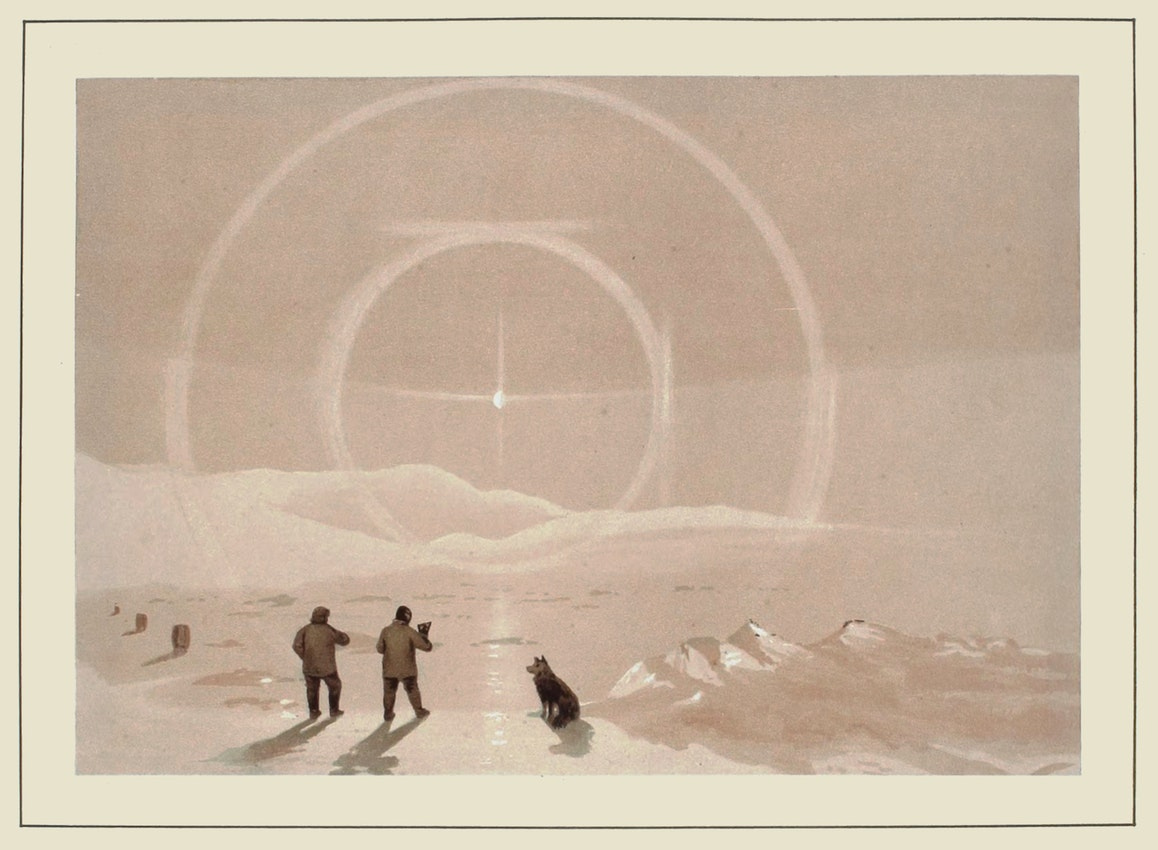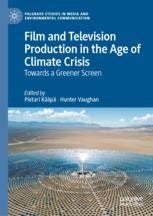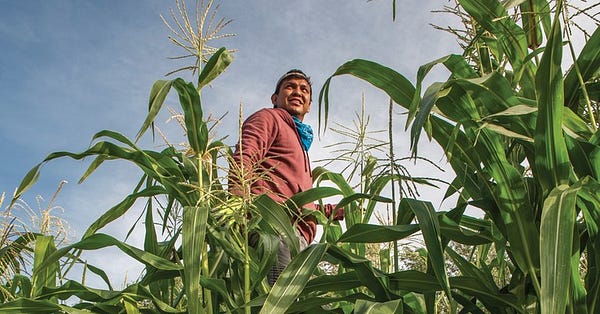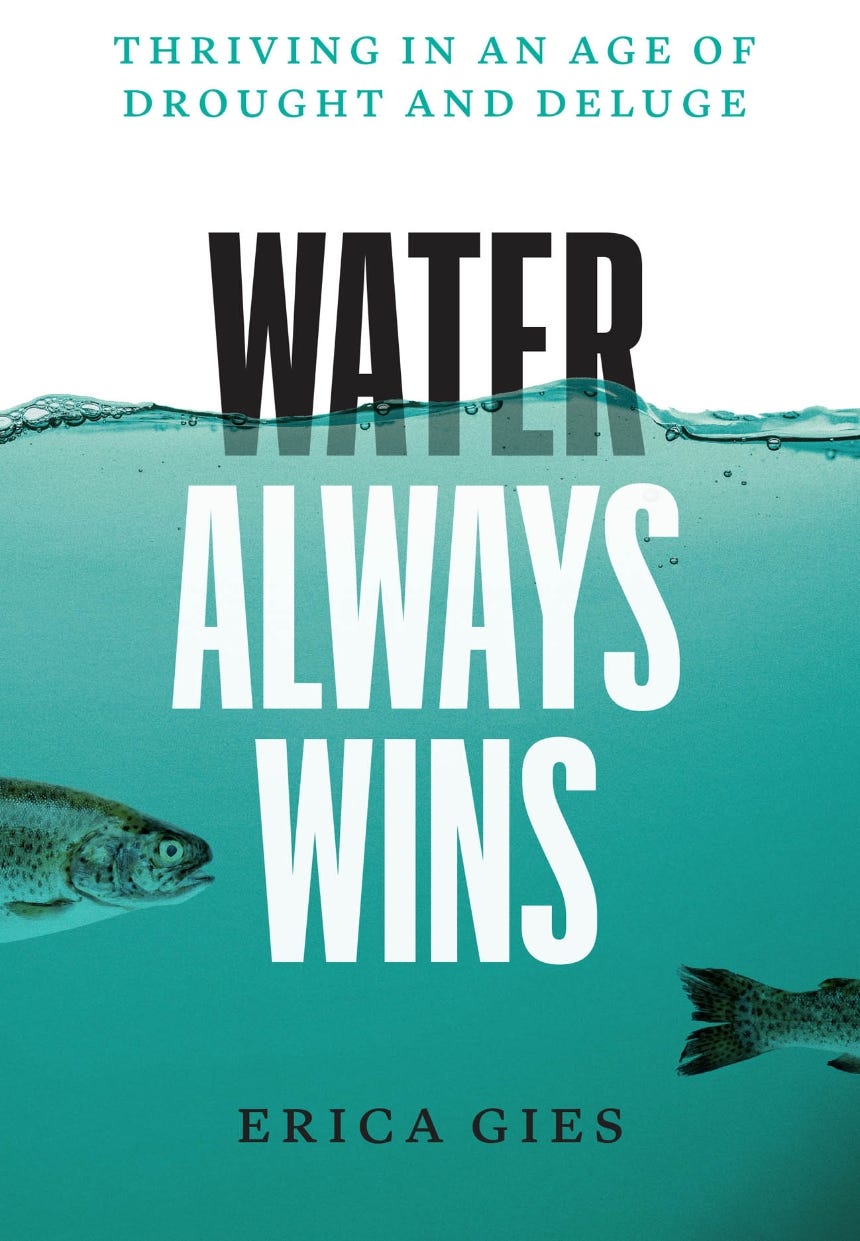🌿Wild Ones #66: Environmental Communication Digest
Environmental Keyword: Topophilia + The Territory + The Global South Climate Database + Freya the Walrus + More!

Hi everyone, welcome back to Wild Ones, a (usually) weekly digest by me, Gavin Lamb, about news, ideas, research, and tips in environmental communication. If you’re new, welcome! You can read more about why I started Wild Ones here. Sign up here to get these digests in your inbox:
🌱Environmental Keyword
Keyword: Topophilia
“The word ‘topophilia’ is a neologism, useful in that it can be defined broadly to include all of the human being's affective ties with the material environment. These differ greatly in intensity, subtlety, and mode of expression.” – Yi-Fu Tuan, in Topophilia: A study of environmental perceptions, attitudes and values. (1974)
The geographer Yi-Fu Tuan developed the notion of topophilia in his book of the same title. He described the book as “a systematic study of how people come to be attached to place.” Yi-Fu Tuan passed away this month on August 10th at the age of 91. It’s been a good while since I read Yi-Fu Tuan’s Topophilia – I think it was during my comprehensive exams for my PhD several years ago. But ‘topophilia’ is one of those memorable keywords that has stuck with me after a brief encounter. A bit like ‘solastalgia’ or ‘Umwelt.’ In a 1988 lecture, Yi-Fu Tuan writes about his surprise at the book’s (brief) popularity with the environmental movement when it was published:
“Topophilia's popularity may be gauged by the fact that at one college bookstore, it was put on a shelf labeled "Astrology and Occult." To my surprise, late-blooming Flower Children found it sympathetic, as did their bible The Whole Earth Catalog. Topophilia's romance with Counter Culture was, however, brief, and would have been even briefer had Counter Culture not dovetailed into the environmental movement.”
In his book Topophilia, Yi-Fu Tuan described himself as a ‘humanistic geographer’. The aim of the book, he wrote, was to explore the powerful role that emotional attachment to our local environment plays in forging our ‘sense of place,’ and in particular, the diverse ways we endeavor to make our home in the world. The geographer Tim Cresswell, a former graduate student of Tuan’s at the University of Wisconsin-Madison, says Yi-Fu Tuan’s notion of topophilia was a reaction to a dominant ‘spatial science’ of objective coordinates and grids in geography at the time. Here’s how Tim puts it in his book, Place: A short introduction:
“Writing in 1974 (before humanistic geography was well known) it is obvious that Tuan was struggling with the abstractions of spatial science. Spatial science simply missed out too much of the richness of human experience for Tuan and despite the lip service paid to 'place' in definitions to geography no-one was really bothering to figure out what it was. It could not be measured or mapped and laws could not be deduced about or from it.” (pp. 20-21).
In contrast to abstract space, Topophilia explores the lively ‘affective bond between people and place’.1 Tuan's division between abstract space and lived place has not been without its critics. The geographer, Doreen Massey, for example, writes that Yi-Fu Tuan's idea of Topophilia – the love or attachment to concrete, local places (like a garden or even just a cozy room in our house) risks romanticizing our emotional connection to ‘the local.’ In the process, we lose sight of how “‘the lived reality of our daily lives’ is utterly dispersed, unlocalised in its sources and repercussions.” This is the point environmental philosopher Val Plumwood also makes when she warns us about how our love for a specific place can actually obscure our interdependence with other places, especially those ‘shadow places’ (‘denied places’ or ‘sacrifice zones’ ) that allow for nice places to be nice.2
I’d have to read more of Tuan’s work to see how, or if he thought about these problems that ‘love of place’ thinking creates for environmentalism: or why we protect some places and sacrifice others. But in addition to writing about ‘the love of place’ in his book about topophilia, he also wrote about topophobia, or ‘the fear of place’ in a 2013 book called Landscapes of Fear. As Tuan puts it, “Love and fear are basic human emotions transformed to varying degrees by imagination and culture,” and how we communicate these culturally-mediated emotions, he later wrote, has the tremendous power to render some places visible, and others invisible.
More on Tuan’s work:
Watch: Legacy of Yi-Fu Tuan: A Panel Discussion: “In honour of Yi-Fu Tuan’s 90th birthday, geographers from around the globe discuss the impact of Tuan’s work and teaching on their own.”
Valerie Hansen, Professor of History, Yale University: “The great geographer Yi-Fu Tuan died in Madison, WI, on August 10th. His 1998 lecture in the ACLS Charles Homer Haskell series, "A Life of Learning," was extremely moving. I recommend it to everyone.”
Reflections on Yi-Fu Tuan, by Tim Cresswell: “[YiFu Tuan] kept bringing me back to big geography questions of space, place, landscape, and mobility – questions I have pursued ever since as fundamental aspects of what it is to be human on earth. Asking such questions is not to deny politics and difference but to insist on the power of geography in ongoing struggles over how we make a home in the world and how we should make a home in the world.”
“Place can be as small as the corner of a room or as large as the earth itself: that the earth is our place in the universe is a simple fact of observation to homesick astronauts... It is obvious that most definitions of place are quite arbitrary. Geographers tend to think of place as having the size of a settlement: the plaza within it may be counted a place, but usually not the individual houses, and certainly not that old rocking chair by the fireplace.”
–Yi-Fu Tuan (1974), cited in Tim Cresswell, Place: A Short Introduction (2013, p. 20)
📚 What I’m reading
Rocky Mountain Massacre: Was Yellowstone’s deadliest wolf hunt in 100 years an inside job? By Ryan Devereaux in The Intercept. I wrote about the U.S. politics of wolf conservation and reintroduction in early July, and if you found that interesting, I really recommend this incredible reported piece on the recent wolf hunts in Yellowstone. Also check out this fascinating recent interview with the author, journalist Ryan Devereaux, on the Wolf Connection Podcast:
On Wandering Angels and Lost Landmarks. By Daegan Miller in Emergence Magazine: “On a visit to the tree that marks the thousandth westward mile of the Transcontinental Railroad, Daegan Miller considers how our historical landmarks have shifted in meaning, leaving us adrift and disoriented in the Anthropocene.”
🎧 What I’m watching
The Territory | Official Trailer | National Geographic Documentary Films: “The Territory, from director Alex Pritz, provides an immersive on-the-ground look at the tireless fight of the Indigenous Uru-eu-wau-wau people against the encroaching deforestation brought by farmers and illegal settlers in the Brazilian Amazon.”
🔍 Tools & Resources I’m exploring

The Global South Climate Database: “The Global South Climate Database is a publicly available, searchable database of scientists and experts in the fields of climate science, climate policy and energy. The goal of the project, set up by Carbon Brief with the support of the Reuters Institute's Oxford Climate Journalism Network, is to ensure that journalists from all over the world can contact scientists from Asia, Africa, Latin America and the Pacific.”


Check out some of the eco-tools (and other stuff) I was exploring last year😊 “🌿Wild Ones #55: 2021 in Review: A recap of 2021 with some of the memorable keywords, tools, research, ideas, tweets, and quotes in ecolinguistics and environmental communication I explored this year in Wild Ones!”
📰 News, Events, and Workshops
🌍Pakistan floods revive a debate: Should U.S. pay for climate disasters? By Shannon Osaka in the Washington Post: “Even as Pakistan turns to donors around the world asking aid to cope with deadly and costly flooding, many politicians and activists demand the United States and others compensate poor nations for global warming damages”

“Freya the walrus euthanized after crowds at Oslo fjord refuse to stay away” by Agence France-Presse, in The Guardian.
As you might know, I live in Oslo, so I’ve been following the journey of Freya closely, a walrus that had spent this summer cruising around the Oslo fjord and lounging on boats. Freya had journeyed across several countries in Europe for many months, becoming an international celebrity in the process, until she was killed by the Norwegian Fisheries Authorities in Oslo, Norway on August 14. I plan to share more of my thoughts about Freya here on Wild Ones soon. But in the meantime, among the many views expressed after Freya was killed, I thought Jeff Sebo, Director of the NYU Animal Studies M.A. Program, had an insightful take in his Twitter thread:

📝Workshop: Nature Writing Workshop: Writing from the Roots: Part II with staff writer Chelsea Steinauer-Scudder:
“This fall, join our virtual course “Writing from the Roots: Part II.” With several guest teachers, we'll explore practices that can deepen our engagement with the living world and add surprising dimension to our writing.”
Indigenous farmers reclaim time-honored techniques: Growing traditions in northern New Mexico. By Lyric Aquino in High Country News.
📚 Research
Communicating climate change in “Don”t Look Up’. By Julie Doyle, in the Journal of Science Communication, 21(05). (2022):
“Climate communication needs to keep in place both climate mitigation and adaptation, making the historical and structural inequalities of capitalism and colonialism the interconnected stories of both [Sultana, 2022]. [Pheadra] Pezzullo states that, “Imagination is a performative survival technique” [2016, p. 804]. If climate justice is to become central to climate action, then popular communication on climate change needs to present such stories as central to the reimagination of a socially just world that responds equitably to the climate crisis, providing a “liveable and sustainable future for all” [IPCC, 2022, p. 35, my emphasis].”
– Julie Doyle, in Communicating climate change in “Don”t Look Up.’


When do environmental NGOs work? A test of the conditional effectiveness of environmental advocacy. By Raul Pacheco-Vega & Amanda Murdie in Environmental Politics (2020)
“In short, we do not find environmental NGO advocacy to be a panacea for environmental improvement. Instead, environmental NGO advocacy works only when conditions are right or ‘ripe’ for a state to make concessions…To the extent that other types of NGOs, like democracy or human rights NGOs, could help improve domestic organizational rights, their work within a state could have future payoffs for environmental NGOs in the area of environmental performance.”

Special Issue: Citizen Linguistic Landscape, bordering practices, and semiotic ideology in the COVID-19 pandemic. Edited by Jackie Jia Lou,
David Malinowski, and Amiena Peck.
new book📚 Film and Television Production in the Age of Climate Crisis: Towards a Greener Screen. Edited by Pietari Kääpä and Hunter Vaughan


💡 Ideas
What Does It Mean to Study Environments in Ukraine Now? By Darya Tsymbalyuk, in Arcadia, Summer 2022, no. 12.: “…to think about the environments of Ukraine now means addressing petrocapitalist dependencies between Russia and the collective West. Only by disengaging from extractivist practices fueling this war, we can start envisioning ways of recuperating the more-than-human worlds and relations that will survive.”
The Principles of Environmental Justice: Drafted and Adopted by the First National People of Color Environmental Leadership Summit in 1991 in DC:

‘This is what reconciliation work can look like.’ An interview with Bonnie McGill by B. Toastie in High Country News: “If people want to support Indigenous sovereignty and those kinds of efforts, looking at place names is a place to start. They’re these windows into a deeper history than most of us know.”
new book!📚 Water Always Wins: Thriving in an Age of Drought and Deluge, by Erica Gies, University of Chicago Press:
“Water Always Wins: Thriving in an age of drought and deluge begins by asking a revolutionary question: What does water want? Most modern development has erased water’s slow phases — wetlands, floodplains, high altitude grasslands and forests — that soften flood peaks, store water for droughts, and keep natural systems healthy. What water wants, say water detectives exploring this question, is a kind of un-engineering that reclaims these slow cycles, offering us greater resilience. For that reason, author Erica Gies calls their efforts the “Slow Water” movement.”
🌎 Today in environmental history
Mary Wollstonecraft Shelley, author of the famous 1818 novel Frankenstein, was born on August 30th, 1797. Here is a piece I wrote on Medium about “the climatic origin of Mary Shelley’s Frankenstein,” and “how climate change caused by the largest volcanic eruption in recorded history inspired the first modern science fiction novel”: The Year Without A Summer
💬 Quote I’m thinking about
“People think that geography is about capitals, landforms and so on…But it is also about place — its emotional tone, social meaning, and generative potential.”
– Yi-Fu Tuan
“Freya the walrus is neither the first nor remotely the last nonhuman climate refugee – or refugee of human activity more generally. There will be quintillions more where she came from…It will be a long time before we know how to build multispecies communities that can be accommodating for humans and nonhumans alike. But when human activity is changing the world, we have a responsibility to try. We should start learning and growing in these ways now.”
– Jeff Sebo, Director of the NYU Animal Studies M.A. Program and the NYU Mind, Ethics, and Policy Program, and author of Saving Animals, Saving Ourselves
Thanks so much as always for your interest in my work, and if you found this digest useful, please consider sharing with others who might find it interesting too😊 I'd also love to hear from you. Leave a comment to let me know what you think about this digest, what areas of environmental communication you’re involved in/most interest you, or anything you’d like to see more of in Wild Ones:)
Yi-Fu Tuan, in Topophilia (1974, p. 4); cited in Tim Cresswell (2013). Place: A Short Introduction. p. 20.
Also see the Shadow Places Network.







I managed to get quite a few typos into this one! I think I caught most but thanks for reading through them😊